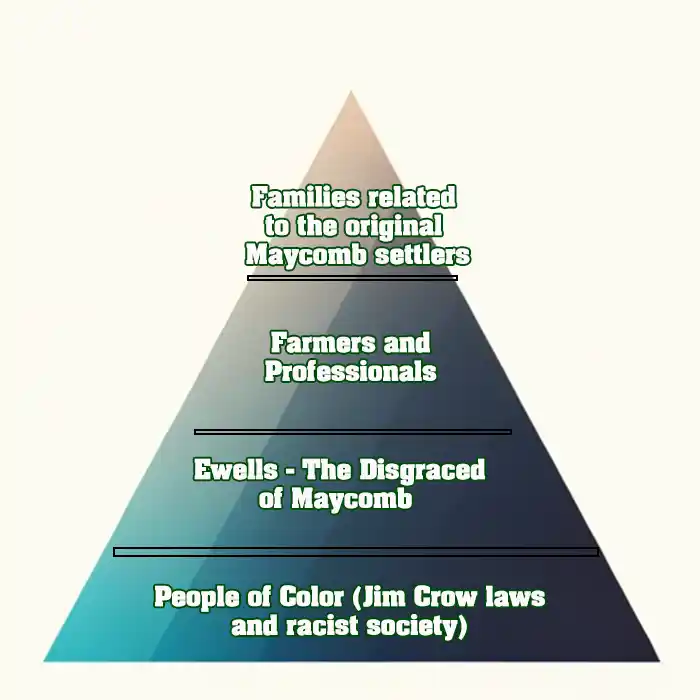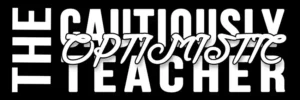This lesson explores the complex socio-economic landscape of Maycomb as portrayed in Harper Lee’s “To Kill a Mockingbird,” focusing on chapter 3. Students will explore the concept of socio-economic status (SES), examining how factors like income, education, and occupation shape the lives and interactions of the novel’s characters, including the Finch, Cunningham, Ewell, and Radley families, as well as the broader black community in Maycomb. Through the RAFT (Role, Audience, Format, Topic) assignment, students will engage in creative and analytical writing, adopting various perspectives from the novel to express a deeper understanding of the socio-economic dynamics at play. This approach not only enhances their comprehension of the novel’s themes but also encourages empathy and critical thinking about the impacts of SES in both the historical context of the novel and in contemporary society.
Learning Goals
- I will be able to analyze and describe how socio-economic status affects the characters in ‘To Kill a Mockingbird’
- I will be able to choose a role from the RAFT assignment and write a response that reflects the character’s perspective on the socio-economic dynamics in Maycomb, using specific details from the novel
- I will be able to use specific evidence from ‘To Kill a Mockingbird’ to support my analysis and understanding of the social hierarchy and SES in Maycomb.
Materials
Process
- Read through the Socio-economic notes with students.
- Read Chapter 3 of To Kill a Mockingbird.
- Read through the instructions for the RAFT assignment and rubric with students. Their responses should be a minimum of 2 paragraphs.
RAFT Assignment Choices
RAFT stands for Role, Audience, Format, and Topic. Choose a role and write for the assigned audience in the correct format and topic. Use specific details from chapters two and three of To Kill a Mockingbird in your answers.
Instructions:
- Choose one Role.
- Pretend that you are that character or person.
- Your task is to write to the audience listed, in the format that is given.
- The topic of your writing is also listed for you.
- Your answer must be a minimum of two (2) paragraphs.
Role: Scout Finch
- Audience: Her teacher, Miss Caroline
- Format: Letter
- Topic: Explaining the social dynamics of Maycomb from a child’s perspective, especially focusing on her experiences with Walter Cunningham in school and at home.
Role: Walter Cunningham
- Audience: Himself
- Format: Diary entry
- Topic: Reflecting on his day at school with Scout and the Finch family, and how it feels to be a part of the Cunningham family in Maycomb.
Role: Miss Caroline
- Audience: Fellow teachers
- Format: Reflective paragraphs
- Topic: Discussing the challenges and revelations of teaching in a town like Maycomb, with particular emphasis on the diverse socioeconomic backgrounds of the students.
Role: Calpurnia
- Audience: Her friend
- Format: Personal letter
- Topic: Describing her perspective on the events of Chapter 3, especially the lunch scene with Walter Cunningham.
Role: Atticus Finch
- Audience: The State Legislature (A state legislature is a group of people who make decisions and laws for a state.)
- Format: Formal Letter
- Topic: As a respected lawyer and member of the State Legislature in Alabama, Atticus Finch writes to other members of the State Legislature to discuss the socio-economic challenges faced by the citizens of Maycomb. He will provide insights into the socio-economic differences within the community, the struggles of some families like the Cunninghams and the Ewells, and advocate for laws to address these issues.
Role: Harper Lee (Author)
- Audience: Aspiring writers
- Format: Interview responses
- Topic: Discussing the motivations and messages behind the creation of characters and social dynamics in Chapter 3.
Role: A Literary Critic
- Audience: Readers of a literary magazine
- Format: Critical analysis
- Topic: Analyzing the representation of class and prejudice in Chapter 3 of “To Kill a Mockingbird” and its impact on the reader’s understanding of the novel’s themes.
RAFT Assignment Marking Rubric
The following rubric is designed to evaluate students’ performance on the RAFT assignment for Chapter 3 of “To Kill a Mockingbird.” The total possible score for this assignment is 20 marks.
1. Adherence to Role (5 Marks)
- 5 Marks: Exceptionally maintains the chosen role, demonstrating a deep understanding of the character’s perspective and voice.
- 4 Marks: Adequately maintains the chosen role with a good understanding of the character’s perspective.
- 3 Marks: Satisfactorily maintains the chosen role but lacks depth in understanding the character’s perspective.
- 2 Marks: Inconsistently maintains the chosen role, with frequent deviations from the character’s perspective.
- 1 Mark: Does not maintain the chosen role, showing little to no understanding of the character’s perspective.
2. Relevance and Response to Prompt (5 Marks)
- 5 Marks: Excellently addresses the entire prompt, demonstrating a thorough understanding of the assignment’s requirements.
- 4 Marks: Adequately addresses most parts of the prompt, showing a good understanding of the assignment’s requirements.
- 3 Marks: Satisfactorily addresses the prompt but misses some key elements or lacks depth.
- 2 Marks: Partially addresses the prompt, with significant omissions or misunderstandings.
- 1 Mark: Does not effectively address the prompt, with minimal relevance to the assignment’s requirements.
3. Use of Textual Evidence (5 Marks)
- 5 Marks: Skillfully incorporates and analyzes relevant textual evidence, enhancing the response’s depth and credibility.
- 4 Marks: Effectively uses textual evidence, but with less sophistication or depth in analysis.
- 3 Marks: Adequately uses some textual evidence, but the connections or analysis are surface-level.
- 2 Marks: Minimally uses textual evidence, with weak connections or little analysis.
- 1 Mark: Fails to use or reference textual evidence relevant to the assignment.
4. Mechanics of Writing (3 Marks)
- 3 Marks: Writing is free of grammatical, spelling, and punctuation errors, demonstrating excellent command of language.
- 2 Marks: Writing contains few grammatical, spelling, or punctuation errors, showing a good command of language.
- 1 Mark: Writing contains several grammatical, spelling, or punctuation errors, affecting readability.
5. Creativity and Engagement (2 Marks)
- 2 Marks: Shows exceptional creativity and engagement with the content, adding depth and originality to the response.
- 1 Mark: Shows some creativity and engagement, but it is limited or conventional.
Total Marks: 20
Social Hierarchy in To Kill a Mockingbird
Socio-Economic Status (SES): Key Points
Definition of Socio-Economic Status:
SES is a measure of a person’s or family’s economic and social position compared to others, based on income, education, and occupation.
Components of SES:
- Income: The money a person or family earns.
- Education: The level of schooling or training a person has received.
- Occupation: The type of job a person has, which often relates to their income and education.
Importance of SES:
- Determines access to resources like healthcare, education, and housing.
- Can affect a person’s lifestyle, including what they eat, where they live, and their overall health.
SES and Society:
- Societies often have a range of SES groups, from low to high.
- Higher SES often means more privileges and opportunities.
- Lower SES can sometimes lead to challenges like less access to quality education or healthcare.
SES and Education:
- Education level can influence SES, as higher education often leads to better job opportunities and higher income.
- Families with higher SES often have more resources to support education.
SES and Health:
- SES can impact health; higher SES often correlates with better health due to access to healthcare, healthier food, and safer living conditions.
Global Perspective:
- SES varies widely around the world.
- Developed countries often have higher average SES than developing countries.
Socio-Economic Status in To Kill a Mockingbird
Setting in the Great Depression:
- The story is set in the 1930s during the Great Depression.
- This era was marked by economic hardship, influencing the economic status of characters in Maycomb.
The Finch Family:
- Relatively higher SES in Maycomb.
- Atticus Finch, a lawyer, provides a stable and comfortable life for his children.
The Cunningham Family:
- Represents a lower SES.
- They barter goods and services instead of using money, showing economic struggles.
- Their pride in self-sufficiency despite poverty.
The Ewell Family:
- Seen as having the second-lowest SES in Maycomb.
- Live in extreme poverty and are not respected by the community.
People of Color in Maycomb:
- Black citizens in Maycomb are generally depicted as having the lowest SES.
- They face systemic discrimination and prejudice, affecting their economic opportunities and social standing.
- The novel subtly introduces this through the setting and background narrative, although specific examples become more prominent in later chapters.
- This lower SES for Black citizens reflects the racial inequalities of the time, which is a central theme of the novel.
Impact on Children and Education:
- SES differences are evident in Scout’s school.
- Walter Cunningham’s inability to afford lunch highlights the impact of SES on daily life.
- Miss Caroline’s misunderstanding of Walter’s situation shows the gap in SES awareness.
Atticus’s Teachings:
- Atticus teaches Scout and Jem to respect all people regardless of SES.
- His approach contrasts with the prevalent attitudes in Maycomb.

“Somewhere, I had received the impression that Fine Folks were people who did the best they could with the sense they had, but Aunt Alexandra was of the opinion, obliquely expressed, that the longer a family had been squatting on one patch of land the finer it was” (p. 130).


